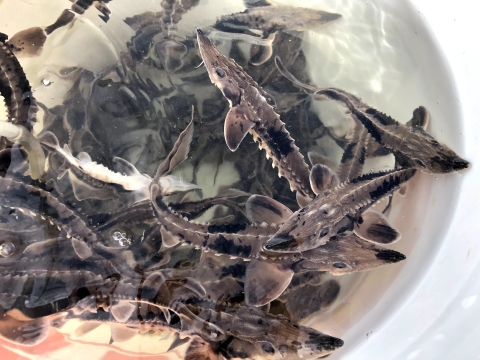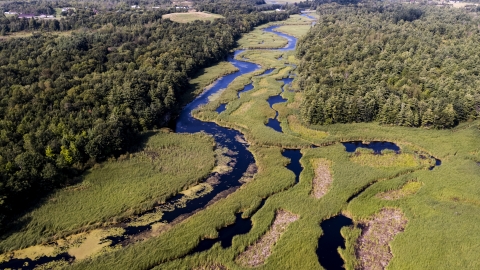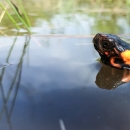What is the Fish Enhancement, Mitigation and Research Fund?
The 24-million-dollar Fish Enhancement, Mitigation and Research Fund (FEMRF) was established as part of the Settlement Agreement reached in the licensing of the St. Lawrence-Franklin D. Roosevelt Power Project, operated by the New York Power Authority (NYPA), near Massena, NY. The FEMRF is managed by the U.S. Fish and Wildlife Service (Service), with the National Fish and Wildlife Foundation (NFWF) serving as the Trustee for the fund. The purpose of the FEMRF is to benefit fisheries resources in the Lake Ontario/St. Lawrence River Basin and to continue research on the American eel and other species that may be affected by the Project.
FEMRF Administration
The Fisheries Advisory Committee (FAC) reviews incoming proposals and advises the Service on the selection of projects for funding from the FEMRF. Two subcommittees of the FAC have been established, the Eel Study Group and the Conservation Work Group. The primary task of both groups is to develop a strategy for requesting, receiving, and evaluating incoming proposals in a particular area of interest.
Eel Study Group
The Eel Study Group (ESG) is a continuation of the Eel Work Group established during the relicensing negotiations for the St. Lawrence-FDR Power Project. It includes representatives from the NYPA, Ontario Ministry of Natural Resources, the New York State Department of Environmental Conservation (NYSDEC), and the Service. The task of this group is to investigate and develop upstream and downstream passage for American eel (Anguilla rostrata) at the Moses-Saunders Dam. Upstream passage for the American eel has been developed and implemented. A state-of-the-art eel ladder was installed in July 2006. The ESG is now focusing its attention on developing a method for downstream passage of the American eel.
Individuals interested in learning more about this work and in submitting proposals for consideration by the FAC should contact Scott Schlueter of the Service at (607) 753-9334 or Scott_Schlueter@fws.gov.
Conservation Work Group
The Conservation Work Group (CWG) includes representatives from U.S. Geological Services, New York Rivers United, the St. Regis Mohawk Tribe, the Thousand Islands Land Trust, Ducks Unlimited, the NYSDEC, NYPA, SUNY-Environmental College of Forestry, and the Service. The expert fisheries scientists included in the CWG are developing a conservation strategy to benefit the recovery of the native fish species and State-listed fish species that were historically found in the St. Lawrence River. These species were discussed at length in the Draft Environmental Impact Statement prepared in 2003 by the Federal Energy Regulatory Commission for the relicensing of the St. Lawrence-FDR Power Project. These same native fish species are also targeted in 18 comprehensive plans developed by international conservation agencies and groups on both sides of Lake Ontario and the St. Lawrence River.
Several target native fish species have been selected to facilitate species-based planning: lake sturgeon (Acipenser fulvescens), muskellunge (Esox masquinongy), northern pike (Esox lucius), walleye (Sander vitreus), and sensitive minnows and darters. The category of sensitive minnows and darters includes primarily the state-listed eastern sand darter (Ammocrypta pellucida), mooneye (Hiodon tergisus), and pugnose shiner (Notropis anogenus).
How to Submit a Proposal to the FEMRF
The Service is looking for projects that will benefit fish species native to the St. Lawrence River and its tributaries. The FEMRF will give priority consideration to any projects related to on-the-ground restoration or enhancement of aquatic habitats for these native fish species. Priority aquatic habitats to enhance or restore are those needed for spawning, rearing, and fish passage fish passage
Fish passage is the ability of fish or other aquatic species to move freely throughout their life to find food, reproduce, and complete their natural migration cycles. Millions of barriers to fish passage across the country are fragmenting habitat and leading to species declines. The U.S. Fish and Wildlife Service's National Fish Passage Program is working to reconnect watersheds to benefit both wildlife and people.
Learn more about fish passage corridors. We are also interested in research that would support downstream passage of the American eel.
The Service also will accept proposals consistent with the purpose of the FEMRF, including mitigation and enhancement of fisheries resources of the Lake Ontario/St. Lawrence River Basin.
All proposals need to include a monitoring component to evaluate the benefits of the research or effects of the habitat improvements on the target population. Operation and maintenance costs for any proposals will only be for a specified period and should be requested with the proposal costs.
Proposals targeting New York State-listed fish species also need to be compatible with NYSDEC's recovery objectives for these species. For more information about these objectives, and additional information about state-listed species, visit the NYSDEC's Endangered & Threatened Fishes of New York page.







